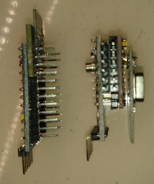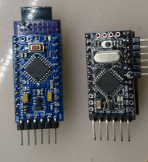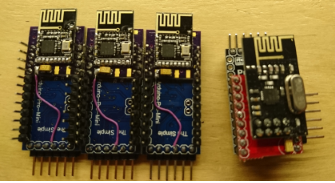I made a few changes to my Wall mounted 'mood light' and translated it to MySensors v2.
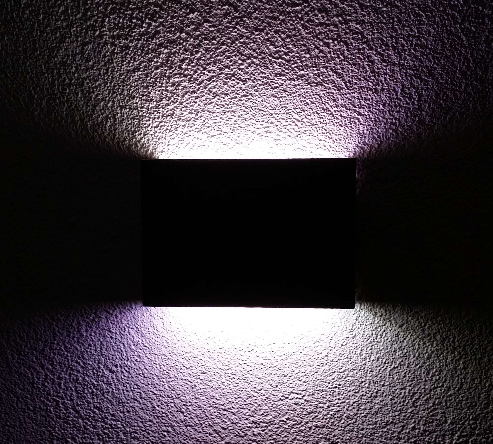
The sketch shows an example of using a Domoticz selector switch attached to a dimmer (V_PERCENTAGE) to switch between the different light patterns (line 413). I'm pretty sure you can use this trick for more controllers.

/*
PROJECT: MySensors / RGB light NEOPIXEL
PROGRAMMER: AWI
DATE: october 10, 2015/ last update: september 20, 2016
FILE: AWI_Wall_LIght_x.ino
LICENSE: Public domain
Hardware: Nano and MySensors 2.0, Wall light 16 WS2812B leds (neopixel)
Special:
uses Fastled library with NeoPixel (great & fast RBG/HSV universal library) https://github.com/FastLED/FastLED
SUMMARY:
Different patterns and brightness settings
Button switches on/off and cycles through all Color patterns on long press
Remarks:
Fixed node-id
Change log:
20160915 - Updated to MySensors 2.0
20160920 - Changed state change to dimmer i.s.o. switch()
*/
//**** MySensors *****
// Enable debug prints to serial monitor
#define MY_DEBUG
#define MY_RADIO_NRF24 // Enable and select radio type attached
//#define MY_RF24_CHANNEL 80 // radio channel, default = 76
#define MY_NODE_ID 62
#define NODE_TXT "W 62" // Text to add to sensor name
// #define MY_RF24_CE_PIN 7 // Ceech board, 3.3v (7,8) (pin default 9,10)
// #define MY_RF24_CS_PIN 8
// helpers
#define LOCAL_DEBUG // enable if print wanted
#ifdef LOCAL_DEBUG
#define Sprint(a) (Serial.print(a)) // macro as substitute for print, enable if no print wanted
#define Sprintln(a) (Serial.println(a)) // macro as substitute for println
#else
#define Sprint(a)
#define Sprintln(a)
#endif
#include <SPI.h> // My Sensors
#include <MySensors.h>
#include <FastLED.h> // https://github.com/FastLED/FastLED
#include "Button.h" // https://github.com/JChristensen/Button
const int stripPin = 5 ; // pin where 2812 LED strip is connected
const int buttonPin = 4 ; // push button
const int numPixel = 16 ; // set to number of pixels (x top / y bottom)
const int RGB_LightChild = 0 ; // Child Id's, standard light child on/off/ dim
const int RGB_RGBChild = 1 ; // RGB light child (on/off/dim/color, if controller supports V_RBG))
const int RGB_SolidColorChild = 2 ; // when set, node reads Color text from ColorTextChild
const int RGB_TextColorChild = 3 ; // Holds Text value for color (custom colors from controller)
const int RGB_AlarmPatternChild = 4 ; // Switches to alarm status
const int RGB_NextPatternChild = 5 ; // Move to next pattern when set
CRGB leds[numPixel];
// Kelving colors: Light & daylight (in Fastled reference only)
/// 1900 Kelvin Candle=0xFF9329 /* 1900 K, 255, 147, 41 */,
/// 2600 Kelvin Tungsten40W=0xFFC58F /* 2600 K, 255, 197, 143 */,
/// 2850 Kelvin Tungsten100W=0xFFD6AA /* 2850 K, 255, 214, 170 */,
/// 3200 Kelvin Halogen=0xFFF1E0 /* 3200 K, 255, 241, 224 */,
/// 5200 Kelvin CarbonArc=0xFFFAF4 /* 5200 K, 255, 250, 244 */,
/// 5400 Kelvin HighNoonSun=0xFFFFFB /* 5400 K, 255, 255, 251 */,
/// 6000 Kelvin DirectSunlight=0xFFFFFF /* 6000 K, 255, 255, 255 */,
/// 7000 Kelvin OvercastSky=0xC9E2FF /* 7000 K, 201, 226, 255 */,
/// 20000 Kelvin ClearBlueSky=0x409CFF /* 20000 K, 64, 156, 255 */
char setRGBvalue[] = "FFC58F"; // Controller sent RGB value, default tungsten40W
uint16_t curBrightness = 0x7F, setBrightness = 0x7F ; // Brightness globals (actualBrightness)
unsigned long updateBrightnessDelay, lastBrightnessUpdate ; // Brightness timers
int RGBonoff ; // OnOff flag
enum { pSolid, pOff, pOn, pAlarm, pFire, pFire2, pCandle, pCircle, pSinelon, pRainbow} ; // Pattern states (stored in int for convenience)
const int lastPatternIdx = pRainbow + 1 ; // use last pattern for patterncount
int curPattern = pSolid ; // current pattern
int setPattern = pSolid ; // set pattern (controller)
unsigned long updatePatternDelay, lastPatternUpdate ; // Pattern timers
unsigned long idleTimer = millis() ; // return to idle timer
const unsigned long idleTime = 10000UL; // return to idle after 10 secs
const unsigned long dimTime = 1000UL; // dim period
const unsigned long heartbeatInterval = 1 * 60UL * 1000UL ; // heartbeatinterval, just to let the controller know I am alive
unsigned long heartbeatCounter = 0 ;
MyMessage lightRGBMsg(RGB_LightChild, V_RGB); // standard messages, light
MyMessage lightdimmerMsG(RGB_LightChild ,V_DIMMER);
MyMessage lightOnOffMessage(RGB_LightChild, V_STATUS);
Button myBtn(buttonPin, true, true, 20); //Declare the button (pin, pull_up, invert, debounce_ms)
// Simple state machine for button state
enum {sIdle, sBrightness, sPattern} ; // simple state machine for button press
int State ;
void setup() {
FastLED.addLeds<WS2812B, stripPin, GRB >(leds, numPixel); // initialize led strip (NEOPIXEL =WS...)
for(int i = 0 ; i < 6 ; i++) { // get color value from EEPROM (6 char)
setRGBvalue[i] = loadState(i) ;
}
setLightPattern(pSolid, 0) ; // default controller Solid
FastLED.show();
State = sIdle ; // Initial state
//randomSeed(analogRead(0));
}
void presentation(){
// MySensors
sendSketchInfo("AWI RGB Wall " NODE_TXT, "2.0");
present(RGB_RGBChild, S_RGB_LIGHT, "RGB Wall RGB " NODE_TXT);// present to controller
present(RGB_LightChild, S_LIGHT, "RGB Wall Light " NODE_TXT);
present(RGB_SolidColorChild, S_LIGHT, "RGB Set Solid color (text) " NODE_TXT);
present(RGB_TextColorChild, S_INFO, "RGB Wall textcolor " NODE_TXT);
present(RGB_AlarmPatternChild, S_BINARY, "RGB Wall Alarm " NODE_TXT);
present(RGB_NextPatternChild, S_DIMMER, "RGB Wall Pattern " NODE_TXT);
}
// read button and act accordingly
// short press: on/off
// longer press: set patterns with following short press
// long press: set brightness increase
void loop() {
myBtn.read(); //Read the button (only read)
unsigned long now = millis(); // loop timer reference
switch (State) {
case sIdle: // default state, browse through patterns
if (myBtn.wasReleased()){ // light on/ off in idle
RGBonoff = !RGBonoff ; // invert light state
setLightBrightness((RGBonoff == 1)?setBrightness:0, dimTime);
send(lightOnOffMessage.set(RGBonoff)); // and update controller
} else if (myBtn.pressedFor(800)){ // move to Pattern update state with long press
idleTimer = now ; // return to idle after ...
State = sPattern ;
}
break ;
case sPattern: // entered after long press
if (myBtn.pressedFor(4000)){ // when press even longer move to Brightness update
State = sBrightness ;
} else if (myBtn.wasPressed()){
setPattern = (setPattern + 1) % lastPatternIdx ; // increase pattern and wrap
setLightPattern((setPattern), 500 );
idleTimer = now ;
} else if ( now > idleTime + idleTimer ){ // return to idle after ...
State = sIdle ;
}
break ;
case sBrightness: // entered after looong press
if (myBtn.wasPressed()){ // if pressed again increase brightness
setLightBrightness((curBrightness+0x1F) % 0xFF, 0) ; // increase brightness and wrap (0..0xFF)
idleTimer = now ;
} else if ( now > idleTime + idleTimer ){ // return to idle after ...
State = sIdle ;
}
break ;
default :
State = sIdle ;
break ;
}
updateLightBrightness(); // update Brightness if time
updateLightPattern(); // update Pattern if time
if ( now > heartbeatCounter + heartbeatInterval){ // heartbeat every hour
sendHeartbeat();
heartbeatCounter = now ;
}
}
// Sets the light brightness, takes value and time (ms) as input
void setLightBrightness(int newBrightness, unsigned long updateTime){
// global: curBrightness, actualBrightness, updateBrightnessDelay
updateBrightnessDelay = updateTime / 0xFF ; // delay = time / max steps
curBrightness = newBrightness ; // set curBrightness to new value, rest is done in update
}
// Update the light brightness if time
void updateLightBrightness(){
// global: curBrightness, actualBrightness, updateBrightnessDelay, lastBrightnessUpdate ;
static byte actualBrightness ; // store real brightness state for slow dim
unsigned long now = millis() ;
if (now > lastBrightnessUpdate + updateBrightnessDelay){// check if time for update
if ( actualBrightness > curBrightness) {
FastLED.setBrightness( actualBrightness-- );
FastLED.show();
} else if ( actualBrightness < curBrightness){
FastLED.setBrightness( actualBrightness++ );
FastLED.show();
}
lastBrightnessUpdate = now ;
}
}
// **** Pattern routines *****
// Sets and initializes the light pattern if nescessary
void setLightPattern( int newPattern, unsigned long updateDelay){
// global: curPattern, updatePatternDelay
static int lastPattern = pSolid ; // last pattern for pOn / pOff virtual patterns
if (newPattern == pOff) lastPattern = curPattern ; // remember last pattern
if (newPattern == pOn) curPattern = lastPattern ; // only for pOn switch to last pattern
else curPattern = newPattern ;
updatePatternDelay = updateDelay ; // delay for next pattern update, can be changed in pattern
switch(curPattern){
case pSolid: // solid is set value in all pixels (and on)
for(int i = 0 ; i < numPixel ; i++) leds[i] = strtol( setRGBvalue, NULL, 16);
setLightBrightness(setBrightness, dimTime) ; // slow dim to on
FastLED.show();
break ;
case pOn: // On is set Brightness in all pixels
setLightBrightness(setBrightness, dimTime) ; // slow dim to on
FastLED.show();
break ;
case pOff: // off state all pixels off (add dim and pOn)
setLightBrightness(0, dimTime) ; // slow dim to off
FastLED.show();
break ;
case pCircle: // all pixels off
for(int i = 0 ; i < numPixel ; i++) leds[i] = 0 ;
for(int i = 0 ; i < 2 ; i++){
leds[i] = strtol( setRGBvalue, NULL, 16) ; // 1 pixel on
}
FastLED.show();
break ;
default :
setLightBrightness(setBrightness, dimTime) ; // slow dim to on
FastLED.show();
break ;
}
}
// Update the light pattern when time for it
void updateLightPattern(){
// global: curPattern, updatePatternDelay, lastPatternUpdate
unsigned long now = millis() ;
if (now > lastPatternUpdate + updatePatternDelay){ // check if time for update
switch (curPattern) {
case pAlarm: // flash light
patternAlarm();
break ;
case pFire: // wild fire
patternFire();
break ;
case pFire2: // cosy fire
patternFire2();
break ;
case pCandle: // flame
patternCandle();
break ;
case pCircle: // flame
patternCircle();
break ;
case pRainbow: // rotating rainbow
patternRainbow();
break ;
case pSinelon: // rotating rainbow
patternSinelon();
break ;
case pSolid: // do nothing fall through
case pOff:
case pOn:
default : // def
break ;
}
lastPatternUpdate = now ;
}
}
// Define the different patterns
// Alarm - intermittent white and red color, full intensity, intermittent top & bottom half
void patternAlarm() {
static boolean topBot ; // indicates direction for next entry
const CRGB colorTop = CRGB(0xFF, 0, 0 ); // red color
const CRGB colorBottom = CRGB(0xFF, 0xFF, 0xFF ); // white color
FastLED.setBrightness(0xFF); // set the strip brightness to max for Alarm
for(int i=0; i <= (numPixel / 2 - 1) ; i++) { // for half of strip size
leds[i] = topBot?colorTop:colorBottom ;
leds[i+ (numPixel/2)] = topBot?colorBottom:colorTop ;
}
topBot = !topBot ; // switch direction
FastLED.show();
}
// Simulate fire with red color, varying number of leds intensity & tempo
void patternFire() {
byte numberLeds = random(0,numPixel); // start number and end of led's for flickering
int lum = ((random(100,255) * curBrightness)) / 0xFF ; // set brightness and scale
CRGB color = CRGB(200, random(70,230),0 ); // get red color with varying green
for(int i=0; i <= numberLeds; i++) {
leds[i] = color ;
FastLED.setBrightness(lum); // set the strip brightness
FastLED.show();
wait(random(0,10)); // (blocking, need to be changed)
}
updatePatternDelay = 100 ;
}
// Simulate fire with red color and varying intensity & tempo
void patternFire2() {
CRGB color = CRGB(200, random(100,150),0); // get red color with varying green
for (byte p=0; p < numPixel; p++) {
leds[p] = color;
}
FastLED.setBrightness((random(50,255) * curBrightness)/ 0xFF ); // set Brightness and scale
FastLED.show();
updatePatternDelay = random(20,300); // variable delay
}
// Simulate candle based on fire with red color, varying number of leds intensity & tempo
void patternCandle() {
byte numberLeds = random(0,numPixel); // start number and end of led's for flickering
byte lum = ((random(100, 255) * curBrightness)/ 0xFF); // set brightness
CRGB color = CRGB(200, random(90,130),0 ); // get red color with varying green
for(int i=0; i <= numberLeds; i++) {
leds[i] = color ;
FastLED.setBrightness(lum); // set the strip brightness
FastLED.show();
wait(random(5,10)); // (blocking, need to be changed)
}
updatePatternDelay = 100 ;
}
// a colored dot sweeping back and forth, with fading trails, adapted from Fastled sinelon
void patternSinelon()
{
fadeToBlackBy( leds, numPixel, 10); // fade all leds a small amount
int pos = beatsin8(25,0,numPixel); // get a new position for the led (BPM = 13, min, max, )
leds[pos] += strtol( setRGBvalue, NULL, 16);
FastLED.show();
updatePatternDelay = 2 ;
}
// Rotate all Leds with current content and trail
void patternCircle() {
static int currentLed ; // indicated current led to light
// CRGB tempLed = leds[0]; // temporary variable for color
fadeToBlackBy( leds, numPixel, 128); // fade all leds for trail..
leds[currentLed] = strtol( setRGBvalue, NULL, 16); // set to current color
currentLed = (currentLed + 1) % numPixel ; // wrap
FastLED.show();
updatePatternDelay = 100 ;
}
void patternRainbow() {
static uint16_t hue ; // starting color
FastLED.clear();
// for(hue=10; hue<255*3; hue++) {
hue = (hue+1) % 0xFF ; // incerease hue and wrap
fill_rainbow( leds, numPixel , hue /*static hue value */, 1);// set a rainbow from hue to last in stepsize 1
FastLED.show();
updatePatternDelay = 100 ;
}
// Incoming messages from MySensors
void receive(const MyMessage &message) {
int ID = message.sensor;
Serial.print("Sensor: ");
Serial.println(ID);
switch (ID){
case RGB_LightChild: // same behaviour as RGB child/ fall through
case RGB_RGBChild: // if controller can handle V_RGB
if (message.type == V_RGB) { // check for RGB type
strcpy(setRGBvalue, message.getString()); // get the payload
setLightPattern(pSolid, 0); // and set solid pattern
} else if (message.type == V_DIMMER) { // if DIMMER type, adjust brightness
setBrightness = map(message.getInt(), 0, 100, 0, 255);
setLightBrightness(setBrightness, dimTime) ;
} else if (message.type == V_STATUS) { // if on/off type, toggle brightness
RGBonoff = message.getInt();
setLightBrightness((RGBonoff == 1)?setBrightness:0, dimTime);
}
break ;
case RGB_SolidColorChild: // request color from controller
if (message.type == V_STATUS) { // if get color from text child
request(RGB_TextColorChild, V_TEXT);
setLightPattern(pSolid, 0); // and set solid pattern (if not alre)
}
break ;
case RGB_TextColorChild: // Text color from controller
if (message.type == V_TEXT) { // if get color from text child
strcpy(setRGBvalue, message.getString()); // get the payload
for(int i = 0 ; i < 6 ; i++) { // save color value to EEPROM (6 char)
saveState(i, setRGBvalue[i]) ;} // Save to EEPROM
}
break ;
case RGB_AlarmPatternChild: // set Alarm pattern
if (message.type == V_STATUS) { // if get color from text child
if (message.getInt() == 1){
setLightPattern(pAlarm, 500); // set slow alarm pattern
} else {
setLightPattern(setPattern, 0); // and reset pattern
FastLED.setBrightness(setBrightness);
}
}
break ;
case RGB_NextPatternChild: // next pattern
if (message.type == V_PERCENTAGE) { // Percentage indicates the pattern
setPattern = map(message.getInt(), 0, 100, 0, 15) % lastPatternIdx ; // mapper dimmer value to state 0..9 and wrap
setLightPattern((setPattern), 500 );
Sprint("Pattern: ") ; Sprintln(setPattern) ;
} else if (message.type == V_STATUS){ // if off switch pattern to default == 0
setPattern = 0 ;
setLightPattern((setPattern), 500 );
Sprint("Pattern: ") ; Sprintln(setPattern) ;
}
break ;
}
FastLED.show();
dispRGBstat();
}
// debug
// display the status of all RGB: controller, requested, real
void dispRGBstat(void){
Serial.print(" Color: "); Serial.print(setRGBvalue);
Serial.print(" Brightness: "); Serial.println(setBrightness);
}

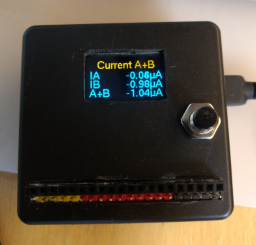
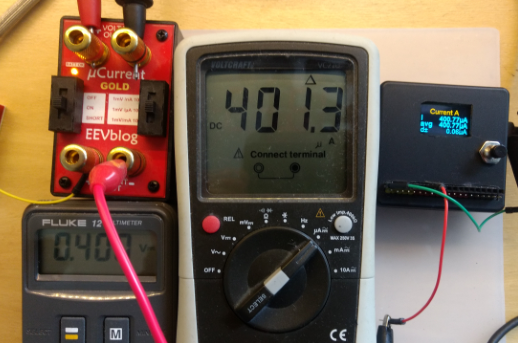

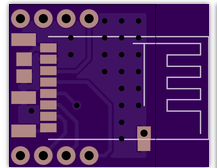
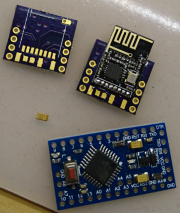 The yellow part is a smd tantalum 4.7uF capacitor. I had the smd nRF24l01 already soldered on the board (takes a little exercise).
The yellow part is a smd tantalum 4.7uF capacitor. I had the smd nRF24l01 already soldered on the board (takes a little exercise).
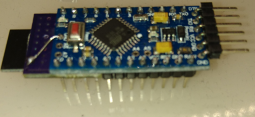 You need wires from the board to Vcc and Gnd.
You need wires from the board to Vcc and Gnd.